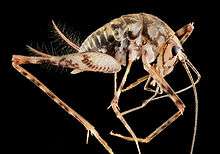Tachycines asynamorus
Tachycines asynamorus is a cave cricket and the type species of the genus Tachycines (Rhaphidophoridae). In English-speaking countries it is known as the greenhouse camel cricket[1] or greenhouse stone cricket[2] for its propensity for living in greenhouses.[3] It was first described in 1902 by Russian entomologist Nicolai Adelung.[4] Some authorities have placed this species in the genus Diestrammena, but it has now restored to its basonym.[3]
| Tachycines asynamorus | |
|---|---|
 | |
| Immature specimen | |
| Scientific classification | |
| Kingdom: | Animalia |
| Phylum: | Arthropoda |
| Class: | Insecta |
| Order: | Orthoptera |
| Suborder: | Ensifera |
| Family: | Rhaphidophoridae |
| Subfamily: | Aemodogryllinae |
| Tribe: | Aemodogryllini |
| Genus: | Tachycines |
| Subgenus: | Tachycines |
| Species: | T. asynamora |
| Binomial name | |
| Tachycines asynamora Adelung, 1902 | |
| Synonyms | |
| |
Description
Tachycines asynamorus is a medium-sized, apterous camel cricket. Its body length ranges from 11.3–14.6 mm (0.4–0.6 in). It has very long antennae, palps, and cerci. The female has a long, gently upcurved ovipositor, 10.7–12 mm (0.4–0.5 in) in length.[1]
Originating in the caves of eastern Asia, it is omnivorous, sometimes carnivorous, or a scavenger of dead insects and other organic material.[1]
Distribution
It is native to Asia, including Korea, but has long been found especially in heated European greenhouses.[1]
People in the United States were asked to survey their homes for presence or absence of camel crickets such as those of this genus and return photographs and/or specimens to North Carolina State University for further research.[5][6][7] Researchers including Rob Dunn have found that introduced greenhouse camel crickets were reported much more commonly than the native North American camel crickets of the genus Ceuthophilus.[6]
References
- Ragge DR (1965). Grasshoppers, Crickets & Cockroaches of the British Isles. F Warne & Co, London. p. 299.
- "Species Diestrammena asynamora - Greenhouse Camel Cricket". bugguide.net. BugGuide.Net. Retrieved 9 June 2019.
- Cigliano, M. M.; Braun, H.; Eades, D. C.; Otte, D. "Tachycines asynamorus". orthoptera.speciesfile.org. Orthoptera Species File. Retrieved 7 June 2019.
- Adelung, Nicolai (1902). "Beitrag zur Kenntnis der Larvenstadien mitteleuropäischer Laubheuschrecken (Orthoptera: Tettigoniidae)". Ezhegodnik Zoologicheskogo Muzeia ... 6. Retrieved 7 June 2019.
- nlmccoy. "Camel Cricket Census". Public Science Lab. Retrieved 2019-10-16.
- Epps, Mary Jane; Menninger, Holly L.; LaSala, Nathan; Dunn, Robert R. (2014-09-02). "Too big to be noticed: cryptic invasion of Asian camel crickets in North American houses". PeerJ. 2: e523. doi:10.7717/peerj.523. ISSN 2167-8359. PMC 4157299. PMID 25210654.
- Johnson, Khishaana (30 October 2014). "Mysterious Crickets Squat in American Homes". Citizen Science Salon. Discover Magazine.
External links
![]()